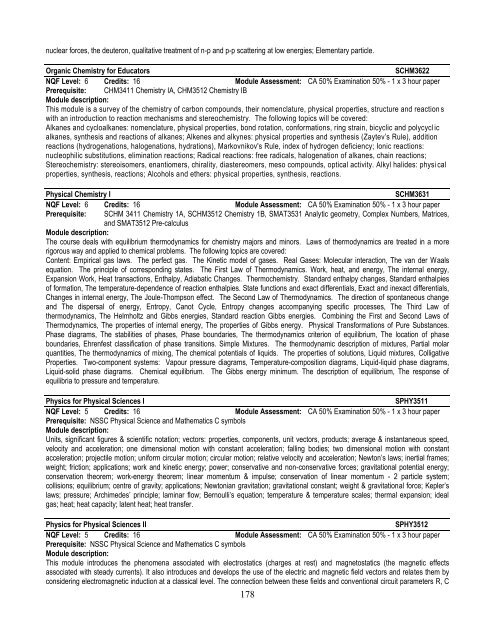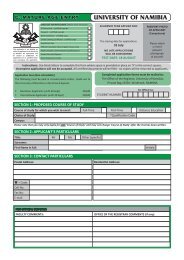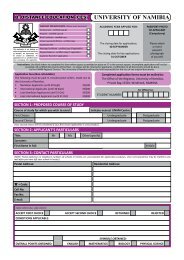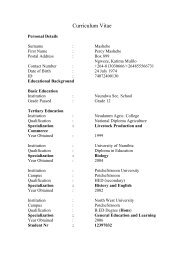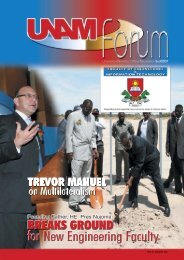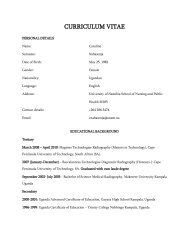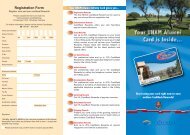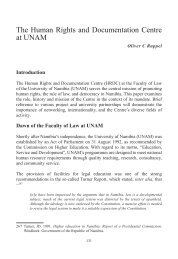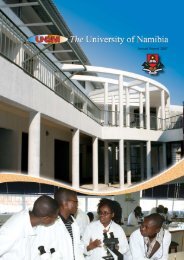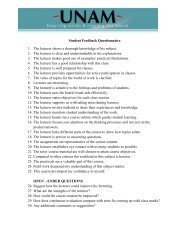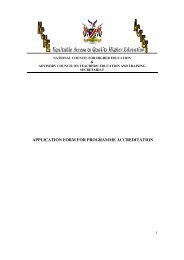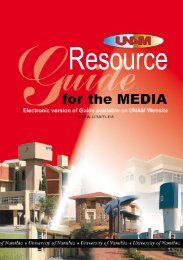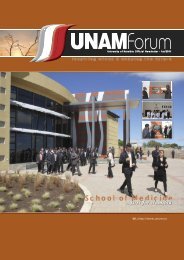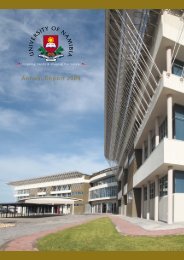UNIVERSITY OF NAMIBIA CENTRE FOR EXTERNAL STUDIES ...
UNIVERSITY OF NAMIBIA CENTRE FOR EXTERNAL STUDIES ...
UNIVERSITY OF NAMIBIA CENTRE FOR EXTERNAL STUDIES ...
Create successful ePaper yourself
Turn your PDF publications into a flip-book with our unique Google optimized e-Paper software.
nuclear forces, the deuteron, qualitative treatment of n-p and p-p scattering at low energies; Elementary particle.Organic Chemistry for EducatorsSCHM3622NQF Level: 6 Credits: 16 Module Assessment: CA 50% Examination 50% - 1 x 3 hour paperPrerequisite: CHM3411 Chemistry IA, CHM3512 Chemistry IBModule description:This module is a survey of the chemistry of carbon compounds, their nomenclature, physical properties, structure and reaction swith an introduction to reaction mechanisms and stereochemistry. The following topics will be covered:Alkanes and cycloalkanes: nomenclature, physical properties, bond rotation, conformations, ring strain, bicyclic and polycycl icalkanes, synthesis and reactions of alkanes; Alkenes and alkynes: physical properties and synthesis (Zaytev’s Rule), additionreactions (hydrogenations, halogenations, hydrations), Markovnikov's Rule, index of hydrogen deficiency; Ionic reactions:nucleophilic substitutions, elimination reactions; Radical reactions: free radicals, halogenation of alkanes, chain reactions;Stereochemistry: stereoisomers, enantiomers, chirality, diastereomers, meso compounds, optical activity. Alkyl halides: physi calproperties, synthesis, reactions; Alcohols and ethers: physical properties, synthesis, reactions.Physical Chemistry ISCHM3631NQF Level: 6 Credits: 16 Module Assessment: CA 50% Examination 50% - 1 x 3 hour paperPrerequisite: SCHM 3411 Chemistry 1A, SCHM3512 Chemistry 1B, SMAT3531 Analytic geometry, Complex Numbers, Matrices,and SMAT3512 Pre-calculusModule description:The course deals with equilibrium thermodynamics for chemistry majors and minors. Laws of thermodynamics are treated in a morerigorous way and applied to chemical problems. The following topics are covered:Content: Empirical gas laws. The perfect gas. The Kinetic model of gases. Real Gases: Molecular interaction, The van der Waalsequation. The principle of corresponding states. The First Law of Thermodynamics. Work, heat, and energy, The internal energy,Expansion Work, Heat transactions, Enthalpy, Adiabatic Changes. Thermochemistry. Standard enthalpy changes, Standard enthalpiesof formation, The temperature-dependence of reaction enthalpies. State functions and exact differentials, Exact and inexact differentials,Changes in internal energy, The Joule-Thompson effect. The Second Law of Thermodynamics. The direction of spontaneous changeand The dispersal of energy, Entropy, Canot Cycle, Entropy changes accompanying specific processes, The Third Law ofthermodynamics, The Helmholtz and Gibbs energies, Standard reaction Gibbs energies. Combining the First and Second Laws ofThermodynamics, The properties of internal energy, The properties of Gibbs energy. Physical Transformations of Pure Substances.Phase diagrams, The stabilities of phases, Phase boundaries, The thermodynamics criterion of equilibrium, The location of phaseboundaries, Ehrenfest classification of phase transitions. Simple Mixtures. The thermodynamic description of mixtures, Partial molarquantities, The thermodynamics of mixing, The chemical potentials of liquids. The properties of solutions, Liquid mixtures, ColligativeProperties. Two-component systems: Vapour pressure diagrams, Temperature-composition diagrams, Liquid-liquid phase diagrams,Liquid-solid phase diagrams. Chemical equilibrium. The Gibbs energy minimum. The description of equilibrium, The response ofequilibria to pressure and temperature.Physics for Physical Sciences ISPHY3511NQF Level: 5 Credits: 16 Module Assessment: CA 50% Examination 50% - 1 x 3 hour paperPrerequisite: NSSC Physical Science and Mathematics C symbolsModule description:Units, significant figures & scientific notation; vectors: properties, components, unit vectors, products; average & instantaneous speed,velocity and acceleration; one dimensional motion with constant acceleration; falling bodies; two dimensional motion with constantacceleration; projectile motion; uniform circular motion; circular motion; relative velocity and acceleration; Newton’s laws; inertial frames;weight; friction; applications; work and kinetic energy; power; conservative and non-conservative forces; gravitational potential energy;conservation theorem; work-energy theorem; linear momentum & impulse; conservation of linear momentum - 2 particle system;collisions; equilibrium; centre of gravity; applications; Newtonian gravitation; gravitational constant; weight & gravitational force; Kepler’slaws; pressure; Archimedes’ principle; laminar flow; Bernoulli’s equation; temperature & temperature scales; thermal expansion; idealgas; heat; heat capacity; latent heat; heat transfer.Physics for Physical Sciences IISPHY3512NQF Level: 5 Credits: 16 Module Assessment: CA 50% Examination 50% - 1 x 3 hour paperPrerequisite: NSSC Physical Science and Mathematics C symbolsModule description:This module introduces the phenomena associated with electrostatics (charges at rest) and magnetostatics (the magnetic effectsassociated with steady currents). It also introduces and develops the use of the electric and magnetic field vectors and relates them byconsidering electromagnetic induction at a classical level. The connection between these fields and conventional circuit parameters R, C178


